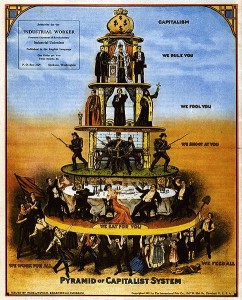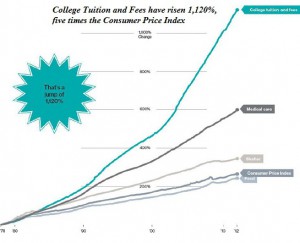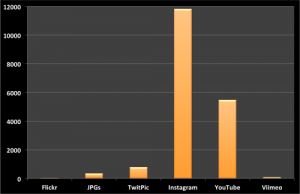
Posting Editor: Owl

Will Crushing Student Loans and Worthless College Degrees Politicize the Millennial Generation? (May 31, 2013)
The existing social and financial order is crumbling because it is unsustainable on multiple levels. The central state is not the Millennials' friend, it is their oppressor.No generation of young people is ever politicized by hunger in distant lands or issues of the elderly. It's no rap on youth that self-interest defines what issues have the potential to radically transform their political consciousness; the transformative cause must reveal the system is broken for them and that it intends on sacrificing their generation to uphold the Status Quo.
The Millennial generation, also known as Gen-Y (Gen-Y comes after Gen-X), is generally defined as those born between 1982 and 2004.
The oldest Millennials were children during the first Iraq War in 1991 (Desert Storm) and just coming of age in 2001 (9/11 and the war in Afghanistan) and the start of the second Iraq War (2003).

The Millennials have entered adulthood in a era characterized by permanent low-intensity wars and central-bank/state managed financial bubbles–2001 to the present. In other words, the only experience they have is of centralized state mismanagement on a global scale.
The gross incompetence of the government and central bank–not to mention the endless power grabs by these centralized authorities–has not yet aroused a political consciousness that the system is irrevocably broken, not just for older generations but most especially for them.
Anecdotally, it appears the Millennial generation is still operating on the fantasy that all they need to do to get a secure, good-paying job and a happy life is go to college and enter the Status Quo machine of government/corporate America.
There are two fatal flaws in this fantasy: the $1+ trillion student loan industry and a transforming economy. The higher education industry in the U.S. operates as a central state-enabled and funded cartel, limiting supply while demand (based on the fantasy that a college degree has critical value) soars. This enables the cartel to keep raising prices even as the value of its product (a diploma) sinks to near-zero.

Curates by Source and Category
Blecko / Environmental Degradation
Blecko / Other Atrocities Human
Here is the abstract of a research paper, that is one of the first things I ever saw that seriously considered the E-government trend, and how it is going to impact citizens. It was published two years ago and, recently a reader sent it to me, and I read it again. I want you to notice how little has changed in the three year! s since it was published. Why is that, do you suppose?
Also note this odd lacuna. There is not discussion of voting, only communications. With our existing technology it is possible to develop e-voting in such a way that each citizen could vote. You wouldn't have to have polling booths, you wouldn't have to mail things, and you wouldn't have to go anywhere. It could be done from any computer, a pad, or a smartphone. To secure it you could use social security numbers, a pre-set-up ID, and a password.
We do billions of financial transactions each day on less security. By comparison this would be 50 state websites, whose Federal totals were simultaneously sent to a Federal website. Everyone eligible could vote in a single day. It would all be completely transparent to the media and the citizens.
It would bypass voter suppression, hanging chads, and all the rest of the schemes. And it would produce a radically different Congress and serve as the counterweight to Citizens' United.
Ask yourself: Why don't we have such a system?
Misplaced Trust? Exploring the Structure of the E-Government-Citizen Trust Relationship
FORREST V. MORGESON III, DAVID VANAMBURG and SUNIL MITHAS – Journal of Public Adminstation Research and Theory
Abstract
A growing body of research focuses on the relationship between e-government, the relatively new mode of citizen-to-government contact founded in information and communications technologies, and citizen trust in government. For many, including both academics and policy makers, e-government is seen as a potentially transformational medium, a mode of contact that could dramatically improve citizen perceptions of government service delivery and possibly reverse the long-running decline in citizen trust in government. To date, however, the literature has left significant gaps in our understanding of the e-government-citizen trust relationship. This study intends to fill some of these gaps. Using a cross-sectional sample of 787 end users of US federal government services, data from the American Customer Satisfaction Index study, and structural equation modeling statistical techniques, this study explores the structure of the e-government-citizen trust relationship. Included in the! model are factors influencing the decision to adopt e-government, as well as prior expectations, overall satisfaction, and outcomes including both confidence in the particular agency experienced and trust in the federal government overall. The findings suggest that although e-government may help improve citizens’ confidence in the future performance of the agency experienced, it does not yet lead to greater satisfaction with an agency interaction nor does it correlate with greater generalized trust in the federal government overall. Explanations for these findings, including an assessment of the potential of e-government to help rebuild trust in government in the future, are offered.

It's happening! Should spread like wildfire once it passes a natural tipping point.
Continue reading “John Maguire: YouTube (3:26) DIY Open Source Cell Phones & Mesh Telephony”

Analysis of Multimedia Shared on Twitter After Tornado
Humanitarian organizations and emergency management offices are increasingly interested in capturing multimedia content shared on social media during crises. Last year, the UN Office for the Coordination of Humanitarian Affairs (OCHA) activated the Digital Humanitarian Network (DHN) to identify and geotag pictures and videos shared on Twitter that captured the damage caused by Typhoon Pablo, for example. So I’ve been collaborating closely with my colleague Hemant Purohit to analyze the multimedia content shared by millions of tweets posted after the Category 5 Tornado devastated the city of Moore, Oklahoma on May 20th. The results are shared below along with details of a project I am spearheading at QCRI to provide disaster responders with relevant multimedia content in real time during future disasters.

For this preliminary multimedia analysis, we focused on the first 48 hours after the Tornado and specifically on the following multimedia sources/types: Twitpic, Instagram, Flickr, JPGs, YouTube and Vimeo. JPGs refers to URLs shared on Twitter that include “.jpg”. Only ~1% of tweets posted during the 2-day period included URLs to multimedia content. We filtered out duplicate URLs to produce the following unique counts depicted above and listed below.
Clearly, Instagram and Youtube are important sources of multimedia content during disasters. The graphs below (click to enlarge) depict the frequency of individual multimedia types by hour during the first 48 hours after the Tornado. Note that we were only able to collect about 2 million tweets during this period using the Twitter Streaming API but expect that millions more were posted, which is why access to the Twitter Firehose is important and why I’m a strong advocate of Big Data Philanthropy for Humanitarian Response.